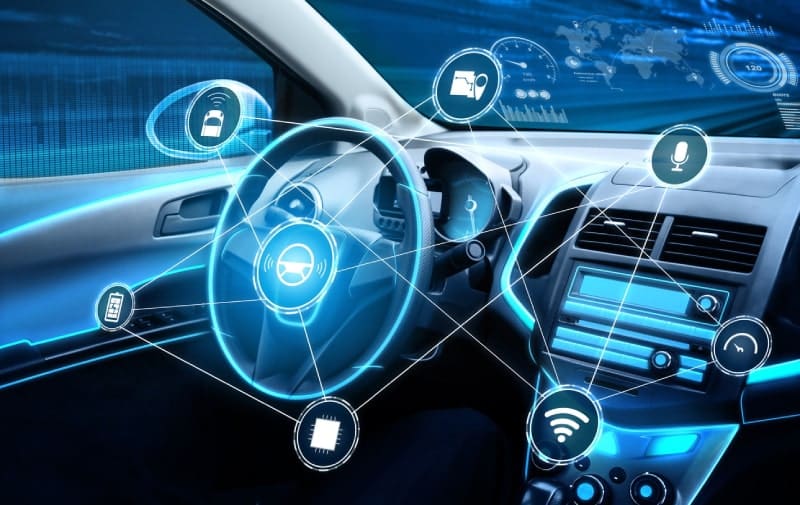When many of us learned to drive, the in-cabin experience of your average car was pretty spartan: an AM/FM stereo, perhaps with a cassette deck or CD player (8-track if you were really old school), and a heating/cooling system with a few levers to control temperature and airflow. In contrast, today’s student drivers often face a complicated array of navigation, infotainment, and environmental controls that are buried in a touchscreen interface.
While these technologies provide an array of benefits, they can easily distract drivers. The advent of automotive AI has introduced advanced assistance technologies that can help drivers stay alert and keep their eyes on the road. Likewise, behind all the bells and whistles of in-cabin amenities lies the most revolutionary breakthrough: AI-powered speech recognition and natural language processing, which makes it possible to control all of those amenities with the sound of your voice.
In general
At its most practical level, AI can do many things on your behalf, such as monitoring a vehicle’s condition and flagging the potential for problems before they happen. For example, AI might monitor the health of a water pump and notify the driver when it’s showing signs of potential failure. By receiving an alert ahead of a mechanical breakdown, you have a much better chance of avoiding costly and inconvenient roadside breakdowns.
AI can also monitor and adjust seat positions, temperature settings, and other variables, based on a driver’s past behavior. It can even analyze your driving habits, past routes, and destination history to suggest the best route to your destination—and AI can notify you of changes in traffic conditions in real-time while suggesting the best alternate route.
But when it comes to driver-initiated actions, AI’s prime directive should be to help drivers stay focused on the road. To this end, natural language processing and speech recognition complement the AI-driven security and safety features in many other ways:
Navigation
Rather than pulling over to enter a destination into your GPS, it is much easier to simply say where you’re going or ask for the fastest route to your destination, whether a specific destination or the point of interest that’s nearest to your current location. Natural language processing enables a vehicle’s AI solution to understand and respond to the driver’s words and intentions, so they can issue navigation commands to the GPS without slowing down.
Infotainment
In the last 10-15 years, touchscreen displays have become standard in most cars, enabling drivers to control virtually every in-cabin amenity, as well as third-party apps on connected mobile devices. Navigating a touchscreen interface while driving isn’t advisable, which is why advances in natural language processing and speech recognition are so compelling for the digital cockpit. Using voice commands, drivers can initiate virtually any task while behind the wheel, whether streaming media, adjusting temperature controls, or sending a text. In some cases, you can even customize voice commands to accommodate your personal preferences.
Voice assistants
The continued adoption of connected car technologies expands the possibilities of what drivers can accomplish while behind the wheel. In fact, a Voicebot study of the adoption of in-car voice assistants found that, for 60 percent of those surveyed, the availability of this technology was one of their considerations when buying a new car. There’s an undeniable convenience to controlling your vehicle’s HVAC with a simple voice command such as “make it cooler,” or “turn on rear defroster,” but the most popular use cases include things like booking appointments, making travel arrangements, and searching for (and ordering) a meal from a drive-thru restaurant of choice.
It’s worth noting that realizing the full potential of in-car voice assistants may require more advanced AI technologies such as Natural Language Understanding and Automatic Speech recognition—and in some of these cases, drivers may need a wireless hotspot.
Mercedes is one automotive company pushing the limits of the in-cabin experience with some very advanced, forthcoming features. Some of these automotive innovations include a passenger-centric, dash-mounted display screen (with 5G connectivity) that only activates when someone rides “shotgun,” built-in Zoom and Web-ex capabilities to conduct conference calls on the road, and the availability of third-party apps such as TikTok, Angry Birds, and the Vivaldi web browser.
Developing effective, speech-driven scenarios that enhance in-cabin experiences starts with having a well-thought-out understanding of the needs of drivers in whichever markets you’re operating, and how they will articulate those needs while behind the wheel. It’s also critical to collect quality audio data of drivers verbalizing those commands in a variety of driving conditions.
Completing these tasks requires a tremendous amount of nuance in identifying how people articulate their commands and in how the audio and speech data is collected and used to train the machine learning algorithms. LXT has the expertise and resources to guide you along the process and help ensure that your driver assistance voice-recognition solution is useful, safe, and secure by training it with data from native speakers in all your target markets.
Contact us today at info@lxt.ai to discuss your data needs with one of our experts.



